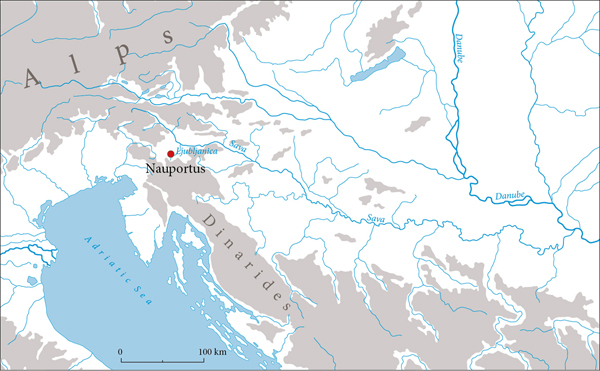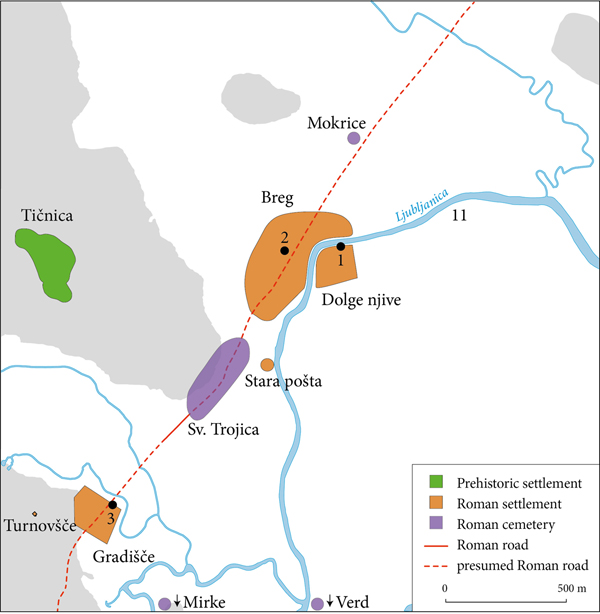A small settlement on the main road − the Roman vicus Nauportus
Principal Investigator at ZRC SAZU
-
Original Title
Mala naselbina ob veliki cesti – rimski vikus Navport
Project Team
-
Project ID
Z6-50194
-
Duration
1 November 2023–31 October 2025 -
SICRIS
https://cris.cobiss.net/ecris/si/en/project/20938 -
Project Leader
-
Financial Source
Slovenian Research and Innovation Agncy

Nauportus is one of the oldest Roman settlements in present-day Slovenia and a key site for understanding the early Roman period and Romanisation in the southeastern Alps.

Geographical location of Nauportus
The settlement, which depended primarily on trade and traffic, developed dynamically during the Roman period, experiencing several ups and downs. It consisted of several separate settlement nuclei (Stara pošta, Dolge njive, Breg, Gradišče). We observe that these parts developed differently, but we do not understand the relationships between them and their functions (e.g. residental area, craftsmen's quarter, port, emporium, roadside station).
The purpose of the project is to analyse and interpret the development of the roadside settlement of Nauportus between the early and late Roman periods. We are particularly interested in the form and organisation of the settlement in the different periods, the role of the settlement in the trade system of the Roman Empire and, on the other hand, the role of the settlement in the local and regional economy.
OBJECTIVE 1: The role and function of the various settlement nuclei in Nauportus and the relationships between them
SETTLEMENT NUCLEUS OF DOLGE NJIVE
We will evaluate field documentation and small finds from unpublished investigations on wooden structure from the bank and riverbed of the Ljubljanica river in the area of Dolge njive from 1985. The stratigraphy will be analysed, a modern georeferenced plan of the structure will be prepared, small finds will be evaluated for the first time. The results of the analysis will be compared with published studies on Roman bridges and harbour structures. The small finds will be compared with more or less contemporaneous material excavated in other areas of Vrhnika (Stara pošta, Dolge njive and Kočevarjev vrt sites), from the Ljubljanica River and from Ljubljana (Emona).
SETTLEMENT NUCLEUS OF BREG
We will analyse the stratigraphy, metal and glass finds from the archaeological site Kočevarjev vrt in the Breg area. The results of the analyses will be compared with the existing chronological scheme of the site based on the analysis of the ceramic material and the results of the dendrochronological and radiocarbon analyses. In analysing the small non-ceramic finds, we will also address the issues of trade and local production. The architectural remains will be analysed according to chronological phases. We will identify the building types and try to reconstruct the settlement form. The identified architectural forms will be compared with the architectural remains of the roadside stations in the area of the Regio X, Raetia, Noricum and Pannonia, in order to draw conclusions about the function of each building.
SETTLEMENT NUCLEUS OF GRADIŠČE
We will analyse the field documentation and finds from the archaeological excavations of the Gradišče 5 site from 1992. The stratigraphy will be analysed and the small finds will be evaluated for the first time. The architecture and the finds will be compared with contemporary remains from Breg area.

Nauportus in the Roman era. 1 − Dolge njive site, wooden structure, 2 − Kočevarjev vrt site, 3 − Gradišče 5 site
OBJECTIVE 2: Long-distance trade along the Amber Road - the case of Nauportus
Imported ceramic material from distant, clearly defined production centres (i.e., sigillata, thin-walled pottery, amphorae, and certain forms of coarse kitchenware) from the Kočevarjev vrt site in the Breg area has already been analysed. The focus of the proposed project will be on the analysis of the imported ceramic material from the Dolge njive - wooden construction and Gradišče 5 sites. We will determine the type and quantity of imported material in different time horizons and reconstruct the dynamics of emergence and abandonment of individual trade flows over time. The results will be compared with published studies on trade relations between Aquileia and the Middle Danube region.
OBJECTIVE 3: Nauportus as a local production centre
We will analyse the stratigraphy and small finds of the archaeological sites of Kočevarjev vrt and Gradišče 5. We will look for evidence of the workshops, production waste, craft tools and semi-finished products. The findings will be placed in context and time. The results will be compared with analyses of crafts from selected Roman settlements in the Caput Adriae area.
TIMETABLE

Articles
- BERDEN, Tina, Early Imperial Amphorae from the Kočevarjev vrt Site in Vrhnika (Nauportus). − In: Ožanić Roguljić, Ivana, Bedić, Željka, Raičković Savić, Angelina (eds.). Eating and Drinking along Ancient Roads and Rivers: Study Opportunities, Archaeological Sources and Open Issues about Diet Habits. Roads and Rivers 3, 2025, 39−50. doi: https://doi.org/10.2307/jj.34854110.9
- BERDEN, Tina, Znaki ante cocturam na keramiki iz Navporta. − Platforma 5: Zbornik študentk in študentov Podiplomske šole ZRC SAZU, 2025, 32−54. doi: https://doi.org/10.3986/9789610510703_02
- BERDEN, Tina, Rimski Navport, lokalno obrtno središče (Roman Nauportus: A Local Crafts Centre). Keria: Studia Latina Et Graeca 26/1, 2024, 41−61. doi: https://doi.org/10.4312/keria.26.1.41-61
Scientific conference contributions
- BERDEN, Tina, Glass finds from Roman Nauportus. − AIHV 23, Mainz, Germany, 8.-12. September 2025, Mainz, Leibniz-Zentrum für Archäologie.
- BERDEN, Tina, Nauportus and its harbour. − Urban vs Rural. Space, Evolution and Transformation, 8. jun. 2024, University of Zadar Citadela, Department of History-Great Hall, Zadar.
- BERDEN, Tina, Rimski Navport, lokalno obrtno središče. − 15. Grošljev simpozij: De re oeconomica: Gospodarstvo v antiki: od torka, 19. marca, do četrtka, 21. marca 2024, Atrij ZRC SAZU, Novi trg 2, Ljubljana.